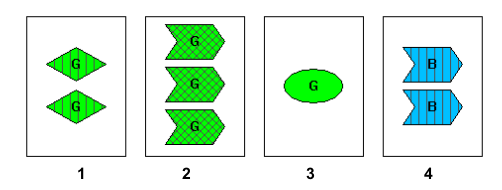5103.PSET
Time Limit: 1s Memory Limit: 256MBPSET is a derivative of the game SET. The game SET has 81 cards, each of which has one, two or three of the same shapes. The shapes are (for this problem):
Arrow: Diamond:
Diamond: and Oval:
and Oval: .
.
Each group of shapes will have a color Red, Green or Blue (labeled R, G or B in case this page is black and white) and a fill type:
Empty: Striped:
Striped: or Filled:
or Filled: .
.
This gives 81 possible combinations. Three cards are a SET, if, for each property (count, color, fill and shape), the property is the same on all three cards or different on all three cards. For example, for the following cards, 1, 2 and 3 form a SET (different counts, same color, different fill, different shape) but 1, 2 and 4 do not form a SET (for several reasons, one of which is 1 and 4 have the same count, 2 has a different count):
Note that given two cards, there is exactly one other card which forms a set with the first two.
We will use the code {count}{color}{fill}{shape} to specify a SET card. For example, the cards above are: 2GSD, 3GFA, 1GEO, 2BSA. {fill} is one of E, S or F for Empty, Striped or Filled respectively. {shape} is one of A, D or O for Arrow, Diamond or Oval respectively.
Each PSET card consists of two set cards different from 2GSD which form a SET with 2GSD. From the example above 3GFA and 1GEO. The SET cards on the PSET card are above one another and rotated 90 degrees. See the example below.
Three PSET cards form a PSET if the (possibly after flipping a card) the top SET cards form a SET and the bottom SET cards form a SET.
In the example below, there are four PSETs. { 1, (flip) 2, }, { 1, 2, 4}, { (flip) 1, 3, 4} and { 2, 3 , (flip)4.
Write a program which takes as input a collection of distinct PSET cards and outputs the number of (three card) PSETs.
Input Format(From the terminal/stdin)
Input consists of multiple lines of input. The first line contains the number $N$ of PSET cards to follow $(4 ≤ N ≤ 20)$. This is followed by $N$ lines of input, one per card. Each card line consists of a four character code (as described above) for the top of the card followed by a space and a four character code for the bottom of the card.
Output Format(To the terminal/stdout)
The output consists of a single line that contains the integer number of PSETs in the input collection.
Sample Input
4 3BFD 1RED 1GSA 3GSO 3REA 1BFO 2REO 2BFA\n · \n · \n · \n · \n
Sample Output
4\n